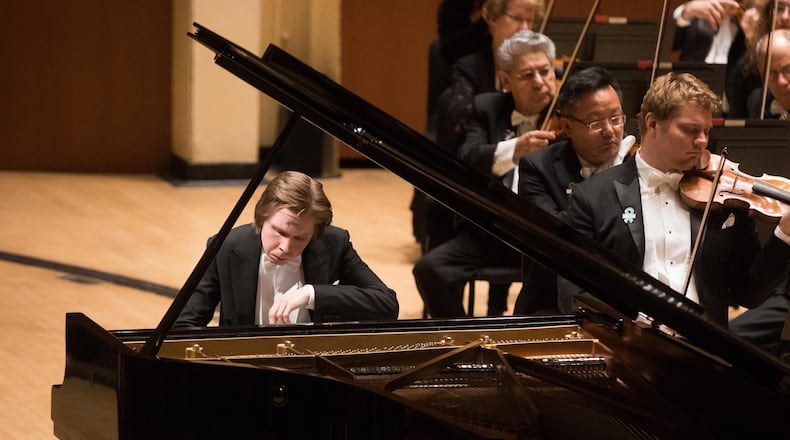At the tail end of the first movement of Beethoven's Piano Concerto No. 4, the Atlanta Symphony Orchestra, which had been playing with intense passion under the baton of music director Robert Spano, stopped short. Guest artist Juho Pohjonen, with his fingers seeming to barely touch the keys, then launched into a dizzying cadenza. He produced bubbly strings of sixteenth notes, ranging up and down the keyboard with an effortless technique.
After a breathtaking array of notes, the ensemble cautiously entered, with light pizzicatos from the strings. The pianist continued his keyboard explorations, even as the orchestra swelled to a moderate roar. These finger-wangling runs were florid but not ostentatious; they seemed like something that could be written down in a challenging etude book — one of those tricky passages to be studied over and over to develop finger speed and dexterity — but performed by Pohjonen, the long strings of notes had a deep, engaging musicality.
When Pohjonen finally stopped playing, it seemed like the perfect point for fulsome applause, but the initial movement of the concerto hadn’t even come to a close.
While Pohjonen, who has made the trip to Atlanta as a guest artist twice before, was the evening’s main attraction, the ASO has never sounded better than it did that initial performance Thursday night at Symphony Hall. The ensemble filled phrases with dynamism, perfectly playing off the effusive piano part. The musicians paid careful attention to blend and dynamics, creating a luxurious base for Pohjonen’s pianistic feats, then swelling sublimely when called upon to take the spotlight.
After intermission, the ensemble confronted Gustav Mahler’s Symphony No. 1, a sprawling, tricky work. The first movement started at a whisper, with a slow, sustained note of ominous caution from the high strings supported by a pedal tone in the bass. Soon, a coterie of off-stage trumpets sounded a hunting call, contrasting this noble-sounding phrase with the relative unease of the onstage music. But these opening phrases of the hourlong symphony sounded uninspired, in contrast to the Beethoven, and proved a bland introduction to the composition.
The second movement, a scherzo, seemed to revive the players. With the cellos sawing away at a staccato musical figure, full of driving downbeats that propelled the music forward, the violins brought forth a folk-tinged melody. Modeled after a popular Austrian folk dance, the second movement righted the ship; the musicians no longer seemed to be playing challenging music, but sounded to be having a bit of fun in the midst of performing a daunting work.
The ensemble performed ably during the rest of the piece, producing passages of pure joy and sublime music that suitably masked intonation issues in the horn section.
On a night where Pohjonen’s guest appearance was billed next to Mahler’s “Titan” symphony, the ensemble’s emotional performance of the Beethoven, coupled with the pianist’s exciting playing, could have easily stood on its own as a fulfilling and complete night of music.
CONCERT REVIEW
Atlanta Symphony Orchestra with Juho Pohjonen
8 p.m. Feb. 9. Additional performance at 8 p.m. Feb. 11. $20-$59. Casual Friday performance of the Beethoven and the fourth movement of Mahler's Symphony No. 1 at 6:30 p.m. Feb. 10. $25. Symphony Hall, 1280 Peachtree St. N.E., Atlanta. 404-733-5000, atlantasymphony.org.
About the Author
Keep Reading
The Latest
Featured


